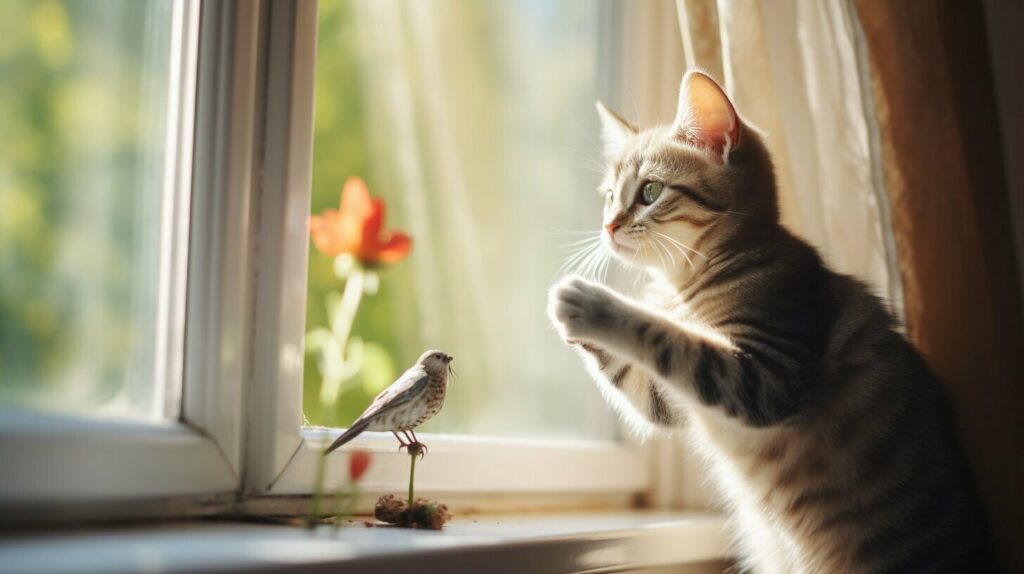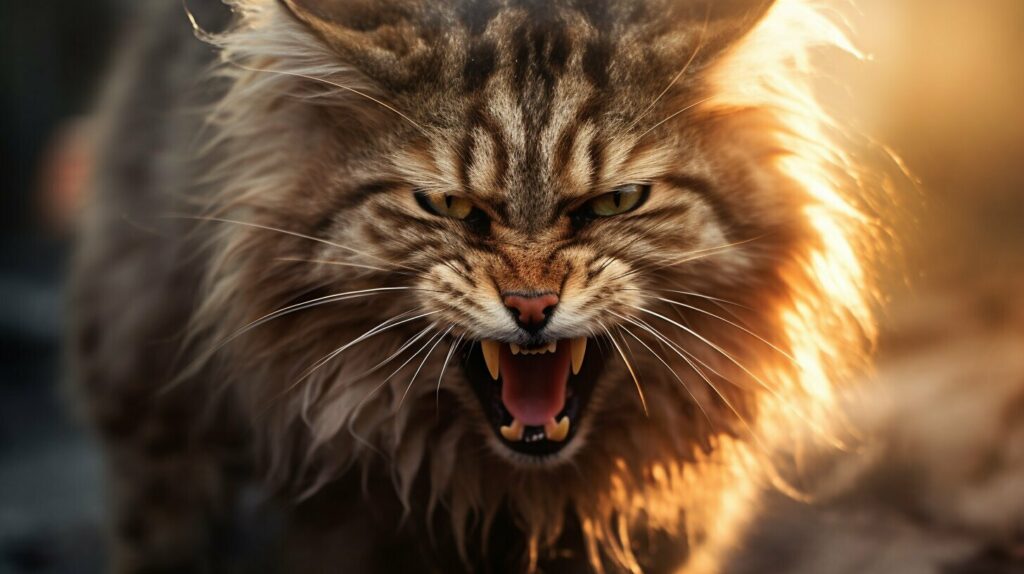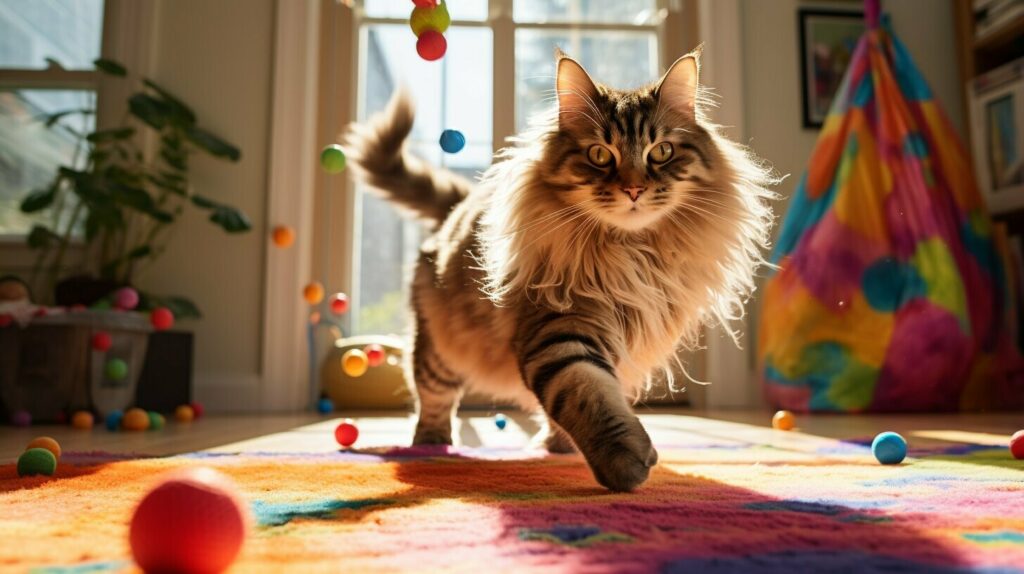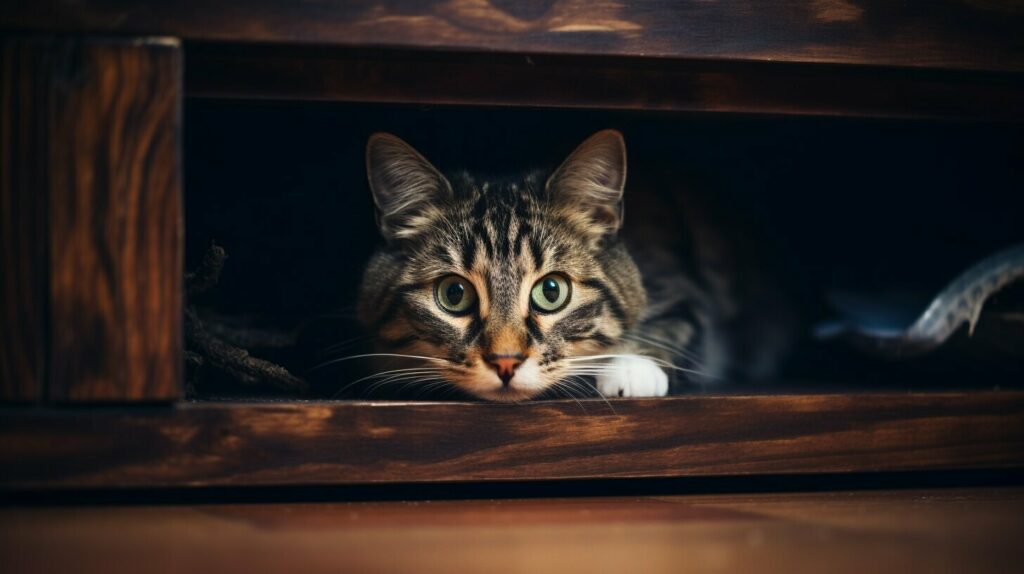If you’ve noticed a shift in your cat’s behavior lately, it’s important not to ignore it. Changes in behavior can be indicative of underlying issues that need to be addressed. As a cat owner, it is crucial to understand what is normal for your furry friend so that you can recognize any behavioral deviations and take appropriate action. Whether it’s aggression, changes in eating habits, decreased playfulness, or any other behavioral change, addressing the root cause is essential for the well-being of your cat.
When it comes to cat behavior problems, it’s important to approach them with patience and understanding. Remember, your cat’s behavior changes are not a result of disobedience or spitefulness. They are often an indication that something is amiss in their world. To help you navigate these changes, I’ve compiled some expert advice and solutions to assist you in supporting your cat through behavioral challenges.
Key Takeaways:
- Changes in cat behavior can indicate underlying health or social issues.
- Understanding what is normal for your cat is important for recognizing behavior changes.
- Aggression, changes in eating habits, decreased playfulness, and hiding are common changes in cat behavior.
- Addressing the root cause is vital, rather than punishing or disciplining your cat.
- Consulting a veterinarian or professional behaviorist can provide valuable guidance and support.
Understanding Cat Behavior Changes
Cats are known for their unique behaviors, but sudden changes in their behavior can be perplexing and concerning for cat owners. Understanding why these behavior changes occur and learning how to manage them is essential for the well-being of our feline friends. Cats may exhibit various changes in behavior, which can be indicative of underlying health or social issues that require attention and care.
“When a cat’s behavior changes, it is important for owners to understand what is normal for their cat in order to recognize any underlying health or social issues.”
Common changes in cat behavior include aggression, changes in eating habits, decreased playfulness, hiding, changes in elimination habits, excessive grooming, vocalizations, and sleeping more than usual. It is crucial to approach these changes with compassion and curiosity, seeking to understand the root cause rather than simply disciplining the cat. Consulting with a veterinarian is an important step to rule out any medical issues that may be contributing to the behavior changes.
“Changes in behavior can indicate pain, fear, or stress, and it is important to address the underlying cause rather than discipline the cat.”
Additionally, if behavior issues persist or escalate, seeking professional help from a qualified behaviorist or veterinarian can provide valuable guidance and support. These professionals can help identify the underlying causes of behavior changes and offer effective strategies for managing and addressing them. Remember, every cat is unique, and by understanding and responding to their behavioral changes, we can foster a happy and harmonious relationship with our feline companions.
Table 1: Common Changes in Cat Behavior
| Behavior Change | Possible Causes | Management Strategies |
|---|---|---|
| Aggression | Pain, fear, territoriality | Provide a safe environment, consult with a behaviorist |
| Changes in Eating Habits | Medical issues, stress, dietary changes | Consult with a veterinarian, ensure a consistent feeding routine |
| Decreased Playfulness | Age, stress, boredom | Engage in interactive play, provide stimulating toys |
| Hiding | Fear, stress, lack of safe spaces | Create hiding spots, provide a calm environment |
| Changes in Elimination Habits | Medical issues, stress, litter box problems | Consult with a veterinarian, maintain a clean litter box |
| Excessive Grooming | Anxiety, skin issues, allergies | Address underlying causes, provide distractions |
| Vocalizations | Pain, attention-seeking, stress | Rule out medical issues, provide mental stimulation |
| Sleeping More Than Usual | Age, illness, stress | Monitor for changes, ensure a comfortable sleeping area |

Common Changes in Cat Behavior
Cats may exhibit various changes in behavior that can range from subtle to more pronounced. It is important for owners to be aware of these changes and understand how to address them. Here are some common changes in cat behavior and techniques to address them:
1. Aggression:
Aggressive behavior in cats can be a result of fear, stress, or territoriality. It is crucial to identify the triggers for aggression and provide a safe and calm environment for your cat. Use positive reinforcement techniques and consult a professional behaviorist if the aggression persists.
2. Changes in Eating Habits:
If your cat’s eating habits suddenly change, it could be a sign of an underlying health issue. It is important to rule out any medical problems by taking your cat to the vet. Additionally, ensure that your cat’s feeding area is clean and comfortable and try providing a variety of food options to stimulate their appetite.
3. Decreased Playfulness:
A decrease in playfulness can be a sign of boredom or lack of mental stimulation. Encourage play by providing interactive toys, engaging in play sessions, and creating a stimulating environment with scratching posts and climbing structures.
4. Hiding:
Hiding behavior in cats can be a response to stress or a need for a safe space. Ensure that your cat has access to hiding spots and quiet areas where they can retreat when they feel overwhelmed. Creating a predictable routine and providing positive experiences can help reduce hiding behavior.
5. Changes in Elimination Habits:
If your cat starts eliminating outside the litter box, it is crucial to rule out any medical issues first. Once medical causes have been ruled out, consider factors such as litter box cleanliness, location, and the type of litter used. Providing multiple litter boxes in different areas of the house can also help address elimination problems.
Remember, every cat is unique, and what works for one may not work for another. If you are unable to address the behavior changes on your own, do not hesitate to seek professional help from a qualified behaviorist or veterinarian. With proper understanding and intervention, you can help your cat navigate through behavior changes and ensure their overall well-being.

Aggression is a common issue that can arise when a cat’s behavior changes, and it is important to address it promptly and effectively. Aggressive behaviors can include hissing, growling, scratching, or biting, and can be directed towards humans, other animals, or even inanimate objects. Understanding the underlying causes of aggression is crucial in finding the appropriate solutions to manage and prevent this behavior.
There are several potential reasons why a cat may exhibit aggressive behavior. It could be a response to fear, pain, or discomfort. It may also be a result of territorial issues, stress, or changes in the cat’s environment. Aggression can also be a learned behavior or be triggered by certain stimuli.
To address aggression in cats, it is essential to create a safe and secure environment. Providing plenty of hiding spots, elevated perches, and separate resources for each cat can help reduce tension and prevent conflicts. Engaging in interactive play sessions and providing mental stimulation can also help redirect excess energy and aggression. It is important to avoid punishing or using forceful measures, as it can exacerbate the aggression and damage the bond between you and your cat.
If your cat’s aggression persists or escalates despite your efforts, it is advisable to seek professional help. A qualified behaviorist or veterinarian can assess the situation, identify the underlying causes, and provide a tailored behavior modification plan. They may also recommend additional interventions such as medication or specialized training techniques.
| Aggression and Behavior Changes |
|---|
| “Aggression is a common issue that can arise when a cat’s behavior changes, and it is important to address it promptly and effectively.” |
Remember, aggression is often a sign that something is amiss in your cat’s life. By understanding the underlying causes and seeking appropriate help, you can work towards resolving the behavior changes and ensure a happier, healthier relationship with your feline companion.
- Identify triggers for aggression and remove them from your cat’s environment.
- Provide safe spaces and resources for each cat in multi-cat households.
- Engage in regular play sessions and provide mental stimulation.
- Avoid punishment and seek professional help if needed.

Cats are known for their finicky eating habits, but significant changes in their appetite or food preferences can be indicative of underlying issues. As a cat owner, it is essential to pay attention to your feline friend’s eating habits and behavior, as they can provide valuable insights into their overall health and well-being.
One common change in eating habits is a sudden decrease or increase in appetite. If your cat starts eating significantly less or more than usual, it may be a sign of an underlying medical issue or stress. It is important to consult with a veterinarian to rule out any health problems and determine the appropriate course of action.
Another behavior change to watch out for is a sudden aversion to certain types of food or a complete loss of interest in eating. This could be a sign of dental issues or gastrointestinal problems. Regular dental check-ups and a well-balanced diet can help prevent these issues, but if they occur, it is crucial to seek professional help to address the problem effectively.
| Signs of changes in eating habits and behavior: |
|---|
| Decreased appetite: Eating significantly less or refusing to eat. |
| Increased appetite: Eating much more than usual. |
| Aversion to food: Refusing to eat certain types of food they previously enjoyed. |
| Loss of interest in food: Showing disinterest or indifference towards eating. |
| Vomiting or diarrhea: These gastrointestinal issues can be linked to changes in eating habits. |
Remember, changes in a cat’s eating habits and behavior should not be ignored. They can be early indicators of underlying health problems or stress. By observing and addressing these changes promptly, you can ensure your cat’s well-being and provide them with the necessary care they need.
The Importance of a Balanced Diet
In addition to monitoring your cat’s eating habits, providing them with a well-balanced diet is essential for their overall health. A diet that meets their nutritional needs can help prevent dietary-related issues and maintain their energy levels and vitality.
“A balanced diet with appropriate levels of protein, fat, and carbohydrates is crucial for maintaining your cat’s health. Consult with your veterinarian to determine the best diet for your cat’s specific needs.”
Furthermore, introducing wet food into your cat’s diet can help increase their water intake, which is crucial for their urinary tract health. Adequate hydration plays a significant role in preventing urinary tract infections and other related issues.
In conclusion, changes in a cat’s eating habits and behavior should be carefully monitored, as they can indicate underlying issues. Seek professional help if necessary, and ensure your cat has a well-balanced diet to support their overall health and well-being.

Playfulness is a key characteristic of cats, but if you’ve noticed a significant decline in your cat’s interest in playtime, it’s important to investigate the underlying causes. A decrease in playfulness can be a sign of various behavior changes that may indicate your cat is experiencing discomfort or stress. By understanding the potential reasons behind this change, you can take appropriate steps to address the issue and help your cat regain their playful nature.
One possible reason for decreased playfulness is physical discomfort. Cats may become less active if they are experiencing pain or discomfort, particularly in their joints or muscles. It’s important to monitor your cat’s mobility and look out for any signs of stiffness or difficulty moving. If you suspect physical discomfort, consult with your veterinarian to address any underlying health issues and explore pain management options.

Another factor that can contribute to decreased playfulness is stress or anxiety. Cats are sensitive creatures and changes in their environment, such as the introduction of a new pet or a move to a new home, can cause them to feel anxious or stressed. Providing a calm and secure environment, as well as engaging in interactive play sessions, can help alleviate these feelings and encourage your cat to play.
It’s important to note that a decrease in playfulness can also be a natural part of aging. As cats get older, their energy levels may decrease, and they may prefer more relaxed activities. However, it’s still crucial to monitor their overall behavior and ensure they are not exhibiting any other concerning changes.
| Possible Causes of Decreased Playfulness | Suggested Solutions |
|---|---|
| Physical discomfort or pain |
|
| Stress or anxiety |
|
| Natural aging process |
|
Hiding and Behavior Changes
If your cat has started hiding more frequently or in unusual places, it’s important to understand the reasons behind this behavior and take appropriate action. Cats may hide when they feel scared, threatened, or stressed. This behavior change could be a sign of an underlying issue that needs to be addressed.
There are several possible reasons why your cat may be hiding. It could be due to a change in their environment, such as the introduction of a new pet or a move to a new home. Some cats hide as a way to cope with stressful situations, while others may hide when they are not feeling well. It’s important to observe your cat’s behavior and look for any other signs of distress or illness.
If you notice that your cat is hiding excessively or for prolonged periods, it’s recommended to consult with a veterinarian. They can help rule out any medical conditions that may be causing the behavior change. In some cases, a cat may require behavioral intervention to help them feel more comfortable and secure in their surroundings.
| Signs | Possible Causes |
|---|---|
| Increased hiding | Stress, fear, anxiety |
| Hiding in unusual places | Discomfort, pain, illness |
| Changes in appetite | Stress, underlying health issues |
| Changes in litter box usage | Fear, urinary tract problems |
“Understanding the reasons behind your cat’s hiding behavior is crucial in providing them with the support and care they need. Don’t dismiss this behavior as just a quirk, as it may be indicative of a larger issue.”
Creating a safe and secure environment for your cat is essential to help alleviate their hiding behavior. Provide hiding spots such as cat trees, cozy beds, or boxes in various areas of your home. This will give them options to feel secure and retreat to when they need it. Additionally, establish a routine for feeding, playtime, and social interaction so that your cat feels more comfortable and can predict what to expect.
Remember, every cat is unique, and behavior changes should not be ignored. By understanding the reasons behind your cat’s hiding behavior and providing appropriate support, you can help them feel secure and happy in their environment.
References:
- Rooke, S. (2019). Cat Behavior Changes: What to Watch Out For. Fear Free Happy Homes. Retrieved from https://fearfreehappyhomes.com/cat-behavior-changes-what-to-watch-out-for/
- Nielsen, B. (2021). Common Cat Behavior Issues and How to Address Them. The Humane Society of the United States. Retrieved from https://www.humanesociety.org/resources/common-cat-behavior-issues

| Cause | Explanation |
|---|---|
| Stress or fear | New environment, loud noises, new pets |
| Medical issues | Pain, illness, discomfort |
| Changes in routine | Travel, moving, disruption in daily life |
| Anxiety | Separation anxiety, phobias |
Changes in Elimination Habits and Behavior
Changes in a cat’s elimination habits can be frustrating and concerning, but they often indicate underlying issues that need attention. Whether it’s urinating outside the litter box or struggling with constipation, it’s important to address these changes promptly to ensure your cat’s health and comfort.
One common cause of changes in elimination habits is a medical issue. Urinary tract infections, bladder stones, or gastrointestinal problems can all lead to changes in a cat’s bathroom behavior. If you notice any changes in your cat’s elimination habits, it’s crucial to take them to the veterinarian for a thorough examination. Your vet will be able to diagnose any underlying medical conditions and provide appropriate treatment.
Another factor that can contribute to changes in elimination habits is stress or anxiety. Cats are creatures of habit, and any disruptions to their environment or routines can cause them to act out. Moving to a new home, changes in the household, or the introduction of a new pet can all trigger stress in cats. Providing a quiet and safe space for your cat, as well as plenty of litter boxes in different locations, can help alleviate their anxiety and encourage proper elimination.
The importance of a clean litter box
Additionally, maintaining a clean litter box is crucial in preventing litter box issues. Cats are naturally clean animals, and they may refuse to use a dirty or smelly litter box. Make sure to scoop the litter box daily and change the litter regularly to keep it fresh and appealing to your cat.
Ultimately, addressing changes in a cat’s elimination habits requires a combination of medical and environmental interventions. By seeking veterinary assistance, providing a stress-free environment, and maintaining a clean litter box, you can help your cat return to their normal elimination habits and ensure their overall well-being.
| Causes of Changes in Elimination Habits | Treatment and Prevention |
|---|---|
| Medical issues such as urinary tract infections or gastrointestinal problems | – Visit a veterinarian for diagnosis and treatment – Administer medication as prescribed – Provide a balanced diet and monitor water intake |
| Stress or anxiety | – Create a safe and quiet space for the cat – Use pheromone sprays or diffusers to promote relaxation – Provide plenty of environmental enrichment and playtime |
| Dirty or smelly litter box | – Scoop the litter box daily – Change the litter regularly – Ensure multiple litter boxes are available in different locations |

If you’ve tried addressing your cat’s behavior changes on your own without success, it may be time to seek professional help. Understanding and managing sudden cat behavior changes can be challenging, especially when there may be underlying health or social issues at play.
When a cat’s behavior changes, it is important to rule out any medical conditions that could be causing these changes. Only a qualified veterinarian can accurately diagnose and provide appropriate treatment for any underlying health issues. They can conduct a thorough examination, perform necessary tests, and offer guidance tailored to your cat’s specific needs.
In addition to medical assistance, consulting a professional behaviorist can be immensely helpful in understanding and addressing your cat’s behavior changes. Behaviorists specialize in feline behavior and can provide valuable insights into the root causes of the changes your cat is experiencing. They can develop a behavior modification plan tailored to your cat’s unique situation, helping to alleviate any stress, anxiety, or other emotional factors that may be contributing to the behavior changes.
Remember, seeking professional help for your cat’s behavior changes is not a sign of failure as a pet owner. It is a proactive step towards ensuring your cat’s well-being and creating a harmonious environment for both you and your feline companion. With the guidance and expertise of a veterinarian and behaviorist, you can work together to address these changes and help your cat lead a happy and fulfilling life.
FAQ
Q: What should I do when my cat’s behavior changes?
A: When your cat’s behavior changes, it is important to understand what is normal for your cat and to recognize any underlying health or social issues. Take your cat to the vet to rule out any medical issues and seek professional help if needed.
Q: What are some common changes in cat behavior?
A: Common changes in cat behavior include aggression, changes in eating habits, decreased playfulness, hiding, changes in elimination habits, excessive grooming, vocalizations, and sleeping more than usual.
Q: How can I address aggression in my cat?
A: Understanding the underlying causes of aggression in cats is key. It is important to avoid punishment and instead focus on implementing appropriate behavior modification techniques, such as providing positive reinforcement and creating a safe and enriching environment.
Q: Why is my cat’s eating habits changing?
A: Changes in a cat’s eating habits can indicate behavior changes. Potential causes include stress, illness, or a change in their food or feeding routine. It is important to address any underlying issues and consult with a veterinarian if necessary.
Q: How can I encourage playfulness in my cat?
A: If you notice decreased playfulness in your cat, providing opportunities for play and mental stimulation is important. Use interactive toys, engage in play sessions, and create a stimulating environment with scratching posts and climbing structures.
Q: Why is my cat hiding more than usual?
A: Cats may hide more than usual due to changes in their environment, fear, or stress. Creating a safe and secure environment for your cat, ensuring they have hiding spots and access to quiet areas, can help alleviate their anxiety.
Q: How do I address changes in my cat’s elimination habits?
A: Changes in a cat’s elimination habits can be a sign of behavior changes. Ensure that the litter box is clean, easily accessible, and located in a quiet area. Consult with a veterinarian to rule out any medical issues and consider implementing behavior modification techniques.
Q: When should I seek professional help for my cat’s behavior changes?
A: It is important to seek professional help if you are unable to address your cat’s behavior changes on your own. A qualified behaviorist or veterinarian can provide guidance and develop a customized plan to address your cat’s specific needs.







